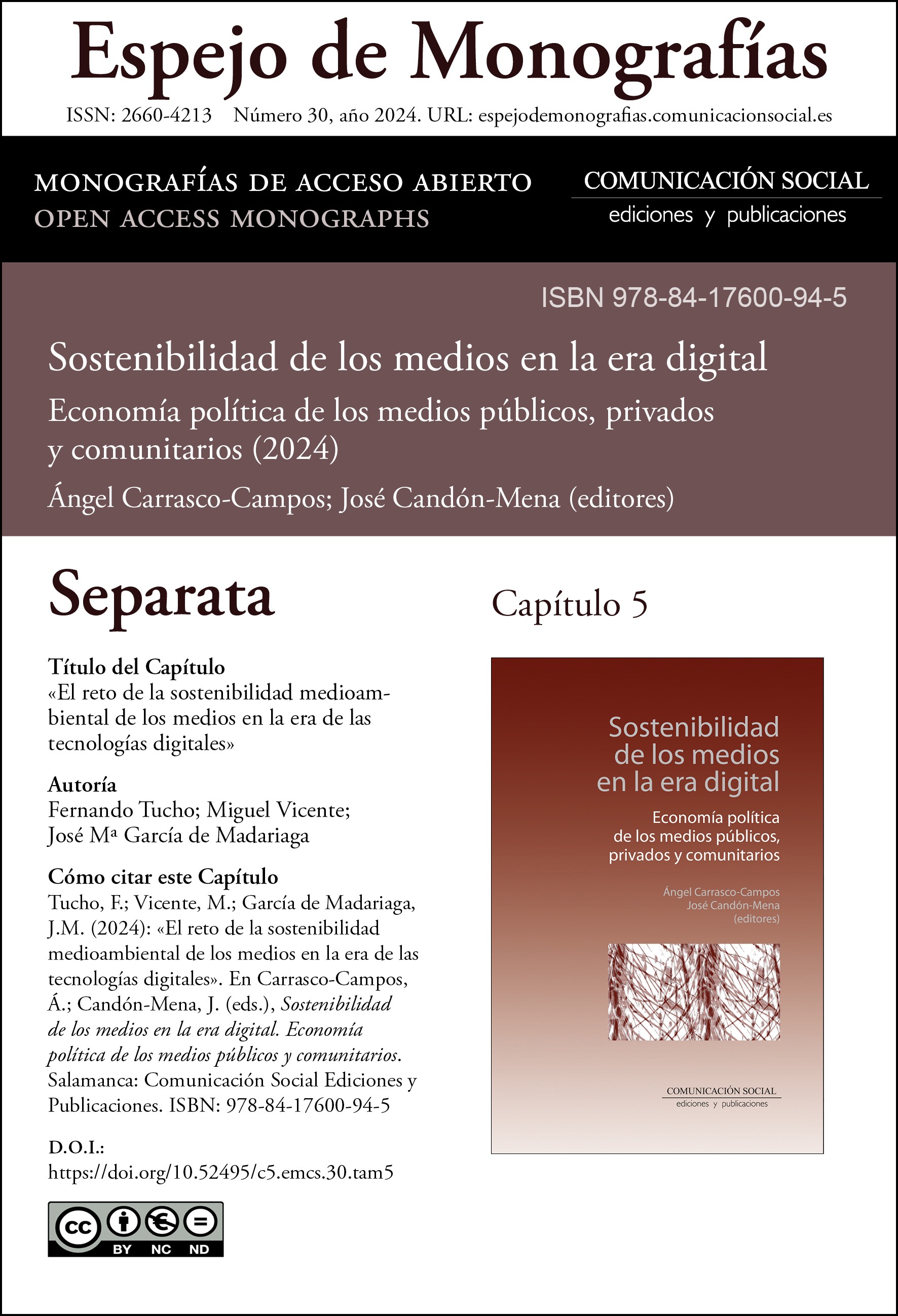Capítulo 5. El reto de la sostenibilidad medioambiental de los medios en la era de las tecnologías digitales
DOI:
https://doi.org/10.52495/c5.emcs.30.tam5Palabras clave:
Sostenibilidad medioambiental, sociedad digital, diseño tecnológico, obsolescencia programada, gestión de residuos, corporaciones tecnológicas, GAFAMResumen
Este capítulo aborda la problemática relación que mantienen los medios de comunicación con la sostenibilidad medioambiental en un ecosistema en el que la esfera digital se ha convertido en el escenario de gran parte de las interacciones sociales cotidianas. La falsa percepción de que la tecnología digital carece de impacto material ha contribuido a presentar las soluciones digitales como un ejemplo de transición ecológica responsable. Siendo cierto que estas transformaciones pueden reducir el impacto de las sociedades industriales clásicas, la promoción de su empleo a escala global, ubicua y constante provoca efectos dañinos para el medio ambiente. Así, este capítulo analiza la digitalización prestando atención a sus efectos en cinco fases diferenciadas: a) el diseño de dispositivos tecnológicos orientados hacia un consumo acelerado y una renovación permanente, b) la extracción de los materiales necesarios para fabricar y mantener el entramado digital que habitamos, c) el proceso de manufactura con sus conflictivas relaciones sociales, económicas y laborales, d) el empleo por parte de individuos y grupos, y e) la gestión de los crecientes desechos tecnológicos. Adicionalmente, se completa un primer abordaje sobre las políticas de responsabilidad social corporativa de las principales corporaciones globales en el sector tecnológico, centrado en las propuestas formuladas en materia de sostenibilidad.
Descargas
Citas
Amnesty International (2017). «Industry giants fail to tackle child labour allegations in cobalt battery supply chains». 15/11/2017. https://www.amnesty.org/en/latest/press-release/2017/11/industry-giants-fail-to-tackle-child-labour-allegations-in-cobalt-battery-supply-chains/
Amnesty International (2020). «DRC: Alarming research shows long lasting harm from cobalt mine abuses».
Barros, M.; Dimla, E. (2021). From planned obsolescence to the circular economy in the smartphone industry: an evolution of strategies embodied in product features. International Conference on Engineering Design, ICED21. 16-20 august 2021, Gothenburg, Sweden. https://www.cambridge.org/core/services/aop-cambridge-core/content/view/789BC8E9DB74AA65104B0C8D36472BAC/S2732527X21004223a.pdf/from-planned-obsolescence-to-the-circular-economy-in-the-smartphone-industry-an-evolution-of-strategies-embodied-in-product-features.pdf
Belkhir, L.; Elmeligi, A. (2018). Assessing ICT global emissions footprint: Trends to 2040 & recommendations. En Journal of Cleaner Production 177 (2018) 448-463. https://doi.org/10.1016/j.jclepro.2017.12.239
Blasco, Lucía (2018). ¿Cuánto tiempo podría durar un celular si no existiera la obsolescencia programada? BBC Mundo News, 20 de noviembre. https://www.bbc.com/mundo/noticias-46261763
Brevini, B.; Swiatek, L. (2022). Amazon. Understanding a Global Communication Giant. Routledge.
Crawford, K. (2016). Can an Algorithm be Agonistic? Ten Scenes from Life in Calculated Publics. Science, Technology, & Human Values, 41(1), 77-92. https://doi.org/10.1177/0162243915589635
Crawford, K. (2021). Atlas of AI: Power, politics, and the planetary costs of artificial intelligence. Yale University Press.
Deloitte (2022). «Making smartphones sustainable: Live long and greener». https://www2.deloitte.com/uk/en/insights/industry/technology/technology-media-and-telecom-predictions/2022/environmental-impact-smartphones.html
DGCCRF (Direction générale de la concurrence, de la consommation et de la répression des fraudes) (2020). «Transaction avec le groupe APPLE pour pratique commerciale trompeuse». 07/02/2020. https://www.economie.gouv.fr/dgccrf/transaction-avec-le-groupe-apple-pour-pratique-commerciale-trompeuse
elEconomista (2022). «El 40% de los usuarios renueva su teléfono móvil cada dos años». El Economista, 11/01/2022. https://www.eleconomista.es/tecnologia-logistica/noticias/11559651/01/22/El-40-de-los-usuarios-renueva-su-telefono-movil-cada-dos-anos.html
Ericsson (2020). A quick guide to your digital carbon footprint. https://www.ericsson.com/en/reports-and-papers/industrylab/reports/a-quick-guide-to-your-digital-carbon-footprint
Eubanks, V. (2017). Automating inequality: How high-tech tools profile, police, and punish the poor (First Edition). St. Martin’s Press.
European NGO Coalition on Conflict Minerals (2021). The EU Conflict Minerals Regulation Implementation at the EU Member State level. Review paper. June 2021. https://www.tecnologialibredeconflicto.org/wp-content/uploads/2021/06/202106_CoreGroup_ReviewPaper_3TG_implementation_MemberStates.pdf
Fairphone (2021). Fairphone’s impact 2021. https://www.fairphone.com/en/impact-report/
Farrás, L. (2023). «¿Lo último en móviles es reacondicionar?». La Vanguardia, 26/02/2023. https://www.lavanguardia.com/economia/20230226/8782411/moviles-reacondicionar-ventas-empresas-nuevos-usados.html
Feenberg, A. (1991). Critical theory of technology. Oxford University Press.
Fernández Durán, Ramón; González Reyes, L. (2018). En la espiral de la energía. Vol. II, Colapso del capitalismo global y civilizatorio (2ª ed). Libros en Acción; Baladre.
Forti, Vanessa; Cornelis Peter Baldé; Ruediger Kuehr, Garam Bel (2020). The Global E-waste Monitor 2020 – Quantities, flows, and the circular economy potential. Global E-waste Statistics Partnership.
Greenpeace (2017). From smart to senseless: the global impact of 10 years of smartphones. http://www.greenpeace.org/usa/wp-content/uploads/2017/03/FINAL-10YearsSmartphones-Report-Design-230217-Digital.pdf
Jackson, T. (2016). Prosperity without Growth. Routledge. https://doi.org/10.4324/9781315677453
Johnson, D. (2022). «Scarcity Drives Fabs to Wastewater Recycling». IEEE Spectrum. 25/01/2022. https://spectrum.ieee.org/fabs-cut-back-water-use
Katwala, A. (2018). «The spiralling environmental cost of our lithium battery addiction». Wired, 5/08/2018. https://www.wired.co.uk/article/lithium-batteries-environment-impact
Klovig, S. (2021). «Mining deaths lawsuit against major tech companies dismissed». ComputerWeekly.com. 5 nov 2021. https://www.computerweekly.com/news/252509170/Mining-deaths-lawsuit-against-major-tech-companies-dismissed
Know the Chain (2020). «2020 ICT Benchmark Overview». June 8, 2020. https://knowthechain.org/2020-ict-overview/
Herman, E.; McChesney, R. (1999). Los medios globales: los nuevos misioneros del capitalismo global. Cátedra.
Howarth, Josh (2023). How Many People Own Smartphones (2023-2028). Exploding Topics. 26 de enero. https://explodingtopics.com/blog/smartphone-stats
Intel (2021). «20-21 Corporate Responsibility Report». http://csrreportbuilder.intel.com/pdfbuilder/pdfs/CSR-2020-21-Full-Report.pdf
Lamtos, T. (2022). Child Labor and Human Rights Violations in the Mining Industry of the Democratic Republic of Congo. Tom Lantos Human Rights Commission in the United States Congress. https://www.youtube.com/watch?v=38EAPDfDeKQ
Lee, M. (2019). Alphabet. The Becoming of Google. Routledge.
Li, W.; Achal, V. (2020). Environmental and health impacts due to e-waste disposal in China – A review. En Science of The Total Environment, Volume 737, 1 October 2020, 139745. https://doi.org/10.1016/j.scitotenv.2020.139745
Little, P. (2019). Bodies, Toxins, and E-Waste Labour Interventions in Ghana: Toward a Toxic Postcolonial Corporality? En Revista de Antropología Iberoamericana. Vol. 14, n1, 51-71. https://www.waunet.org/wcaa/archive/downloads/wcaa/dejalu/march_2021/AIBR,%20Revista%20de%20Antropolog%C3%ADa%20Iberoamericana_translation.pdf
Malinauskaite, J.; Bugra, F. (2021). Planned Obsolescence in the Context of a Holistic Legal Sphere and the Circular Economy. En Oxford Journal of Legal Studies, Vol. 41, No. 3 (2021) pp. 719-749. doi:10.1093/ojls/gqaa061
Mancini, L.; Nicolas, E.; Traverso, M.; Mathieux, F. (2021). Assessing impacts of responsible sourcing initiatives for cobalt: Insights from a case study. En Resources Policy, Volume 71. https://doi.org/10.1016/j.resourpol.2021.102015
Masanet, E.; Shehabi, A.; Lei, N.; Smith, S.; Koomey, J., (2020). Recalibrating global data center energy-use estimates. Science 367 (6481), 984-986.
Mattelart, A. (2002). Historia de la sociedad de la información. Paidós.
Maughan, T. (2015). «The dystopian lake filled by the world’s tech lust». BBC Future. 2nd April. https://www.bbc.com/future/article/20150402-the-worst-place-on-earth
Maxwell, R.; Miller, T. (2020). How green is your smartphone? Cambridge: Polity Press.
McChesney, R.W. (2013). Digital disconnect: How capitalism is turning the Internet against democracy. The New Press.
Miranda, L. (2022): «La Unión Europea quiere que Apple, Samsung y otros fabricantes garanticen piezas de reparación por más tiempo». Hipertextual, 1/09/2022. https://hipertextual.com/2022/09/la-union-europea-quiere-que-apple-samsung-y-otros-fabricantes-garanticen-piezas-de-reparacion-por-mas-tiempo
Moore, J.W.; Castro Lage, M.J. (2020). El capitalismo en la trama de la vida: Ecología y acumulación de capital. Traficantes de Sueños.
MWAP (Metal Workers Alliance of the Philippines) (2022). Conditions of Electronics Workers in the Philippines. https://youtu.be/wSsziep6oSI
Netflix (2020). Environmental Social Governance. 2019 Sustainability Accounting Standards Board (SASB) Report. https://s22.q4cdn.com/959853165/files/doc_downloads/2021/03/2020-SASB-Report_FINAL.pdf
Noble, S.U. (2018). Algorithms of oppression: How search engines reinforce racism. New York University Press.
O’Dea, S. (2023). Smartphones - Statistics & Facts. Statista, 16 de marzo. https://www.statista.com/topics/840/smartphones/#topicHeader__wrapper
O’Neil, C. (2016). Weapons of math destruction: How big data increases inequality and threatens democracy (First edition). Crown.
Obringer, R.; Benjamin R.; Debora M.; Maryam A.; Roshanak N.; Kaveh M. (2021). The overlooked environmental footprint of increasing Internet use. Resources, Conservation and Recycling, Volume 167.
Parlamento Europeo (2023). «Residuos de aparatos eléctricos y electrónicos en la UE: datos y cifras». https://www.europarl.europa.eu/news/es/headlines/society/20201208STO93325/residuos-de-aparatos-electricos-y-electronicos-en-la-ue-datos-y-cifras
Preist, C.; Schien, D.; Shabajee, P. (2019). Evaluating Sustainable Interaction Design of Digital Services: The Case of YouTube. In Proceedings of CHI Conference on Human Factors in Computing Systems Proceedings, Glasgow, Scotland UK, May 4-9, 2019 (CHI 2019). https://doi.org/10.1145/3290605.3300627
Pigem, J. (2021). Pandemia y posverdad: La vida, la conciencia y la cuarta revolución industrial (1. ed). Fragmenta Editorial.
Proske, M.; Jaeger-Erben, M. (2019). Decreasing obsolescence with modular smartphones? – An interdisciplinary perspective on lifecycles. Journal of Cleaner Production. Volume 223, Pages 57-66. https://doi.org/10.1016/j.jclepro.2019.03.116
Ramchandani, A. (2018). «Forced Labor Is the Backbone of the World’s Electronics Industry». The Atlantic, June 28. https://www.theatlantic.com/business/archive/2018/06/malaysia-forced-labor-electronics/563873/
Rautela, R.; Arya, A.; Vishwakarma, S.; Lee, J.; Kim, K; Sumar, S. (2021). E-waste management and its effects on the environment and human health. En Science of The Total Environment, Volume 773, 145623. https://doi.org/10.1016/j.scitotenv.2021.145623
Ross, A.; Christie, L. (2022). Energy consumption of ICT. Research briefing. 1/09/2022. UK Parliament. https://post.parliament.uk/research-briefings/post-pn-0677/
Schomber, A.; Mostert, C.; Bringezu, S. (2023). Environmental footprints show the savings potential of high reparability through modular smartphone design. Research Square. https://doi.org/10.21203/rs.3.rs-2724319/v1
Sovacool, B. (2019). The precarious political economy of cobalt: Balancing prosperity, poverty, and brutality in artisanal and industrial mining in the Democratic Republic of the Congo. En The Extractive Industries and Society, Volume 6, Issue 3, Pages 915-939. https://doi.org/10.1016/j.exis.2019.05.018
Statista (2023). Smartphone subscriptions worldwide 2016-2021, with forecasts from 2022 to 2027. https://www.statista.com/statistics/330695/number-of-smartphone-users-worldwide/
Taibo, C. (2020). Colapso: Capitalismo terminal, transición ecosocial, ecofascismo (Cuarta edición: Enero, 2020). Libros de la Catarata.
The Engineered Environment (2013). «Water Use in the Semiconductor Manufacturing Industry». https://engineeredenvironment.tumblr.com/post/30464844411/water-use-in-the-semiconductor-manufacturing
The Good Electronics (2021). E-waste in Ghana. 28/12/2021. https://goodelectronics.org/e-waste-in-ghana/
The Shift Project (2019a). «Lean ICT: Towards digital sobriety». https://theshiftproject.org/en/article/lean-ict-our-new-report/
The Shift Project (2019b). «Climate crisis: The unsustainable use of online video». https://theshiftproject.org/wp-content/uploads/2019/07/2019-02.pdf
The Shift Project (2020). Did The Shift Project really overestimate the carbon footprint of online video? https://theshiftproject.org/en/article/shift-project-really-overestimate-carbon-footprint-video-analysis/
Turner, A. (2023). The Average Lifespan of a Smartphone (2023). Bankmycell. https://www.bankmycell.com/blog/average-lifespan-of-smartphone
US Department of Labor (2020). 2020 List of goods produced by child labor or forced labor. https://www.dol.gov/sites/dolgov/files/ILAB/child_labor_reports/tda2019/2020_TVPRA_List_Online_Final.pdf
Vogel, C. (2021). Conflict Minerals, Inc.: War, Profit and White Saviourism in Eastern Congo. Oxford University Press, NY.
Winner, L. (2020). The whale and the reactor: A search for limits in an age of high technology (Second edition). University of Chicago Press.
Wise, J. (2023). Smartphones statistics 2023: how many people have smartphones? Earthweb. 9 de marzo. https://earthweb.com/smartphone-statistics/
Wu, T. (2016). El interruptor principal: Auge y caída de los imperios de comunicación. Fondo de Cultura Económica.

Publicado
Cómo citar
Número
Sección
Licencia

Esta obra está bajo una licencia internacional Creative Commons Atribución-NoComercial 4.0.
Los artículos publicados en la revista se distribuyen con la Licencia Creative Commons Atribución-NoComercial-SinDerivadas 4.0 Internacional










